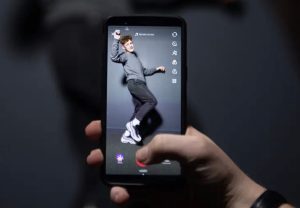The Role of AI in Personalization
Artificial intelligence has revolutionized how social media platforms operate, particularly in personalizing user experiences. By analyzing user data—such as interactions, preferences, and even emotional responses—AI algorithms curate content tailored to individual users. This personalization enhances user engagement and satisfaction, as users are more likely to interact with content that resonates with their interests.
For instance, Instagram’s algorithm adjusts the order of posts in users’ feeds based on their previous likes, shares, and comments. This means that if a user frequently engages with posts related to fitness, the algorithm prioritizes similar content, creating a tailored experience.
Benefits of AI-Driven Personalization

Enhanced User Engagement:
Personalized content tends to resonate more with users, leading to higher interaction rates. Studies have shown that users are significantly more likely to engage with content that reflects their interests and preferences.
Increased Brand Loyalty:
When brands leverage AI to deliver tailored experiences, consumers feel understood and valued. This fosters a sense of loyalty, as customers are more inclined to return to brands that recognize their preferences.
Improved Marketing Strategies:
Marketers can use AI insights to target specific demographics more effectively, optimizing their ad spend and increasing conversion rates. AI can analyze past campaign performance and suggest adjustments to maximize ROI.
Case Study: Netflix
Netflix is a prime example of AI-driven personalization. The platform uses advanced algorithms to analyze viewers’ habits and preferences, allowing it to recommend content tailored to individual users. In 2020, it was reported that around 80% of the content watched on Netflix came from recommendations, underscoring the platform’s success in keeping viewers engaged. By delivering personalized suggestions, Netflix not only enhances user satisfaction but also reduces churn rates, as subscribers are more likely to remain engaged with content they enjoy.
Example: Spotify
Similarly, Spotify employs AI to enhance user experiences. The platform’s “Discover Weekly” feature generates personalized playlists based on users’ listening habits, introducing them to new music that aligns with their tastes. This feature has garnered immense popularity, with millions of users eagerly awaiting their weekly recommendations. By personalizing music discovery, Spotify has significantly increased user engagement and satisfaction.
2. Video Content Dominance and Short-Form Video Trends

The Rise of Short-Form Video Content
Video content has become a dominant force in social media, particularly with the rise of platforms like TikTok, Instagram Reels, and YouTube Shorts. Short-form video content—typically lasting less than 60 seconds—has transformed how brands communicate with audiences. These bite-sized videos allow for quick storytelling and engagement, making them ideal for today’s fast-paced digital environment.
Benefits of Video Content
Higher Engagement Rates:
Video content generally receives more engagement than static images or text posts. According to studies, users are significantly more likely to share and interact with video content, making it a powerful tool for brands looking to capture attention.
Enhanced Storytelling:
Video allows brands to tell their stories in a more dynamic and engaging manner. Visual storytelling can evoke emotions and create connections with audiences that text or images alone may not achieve.
Increased Reach:
Social media algorithms often favor video content, leading to greater visibility in users’ feeds. Brands that invest in video marketing are more likely to reach wider audiences.
Case Study: Chipotle
Chipotle effectively harnessed the power of short-form video content through its #GuacDance challenge on TikTok. The campaign encouraged users to showcase their best dance moves in celebration of National Avocado Day, leveraging a catchy tune and fun dance. The challenge quickly went viral, resulting in over 250,000 video submissions and a significant increase in sales—over 100% compared to the previous year’s avocado day. By tapping into TikTok’s unique culture and engaging users creatively, Chipotle successfully drove brand awareness and sales.
Example: GoPro

GoPro has built a robust community around user-generated video content. The company encourages customers to share their adventure videos using GoPro cameras, showcasing their products’ capabilities. By featuring user-generated content on its social media channels, GoPro not only strengthens its community but also demonstrates the product’s versatility and appeal. This strategy has led to increased brand loyalty and engagement, as users feel a part of the GoPro story.
3. Augmented Reality (AR) and Virtual Reality (VR) Integration
The Integration of AR and VR
AR and VR technologies are transforming social media by providing immersive experiences that engage users in unique ways. AR allows users to interact with digital content in their real-world environment, while VR offers entirely immersive digital experiences. Platforms like Snapchat and Instagram have successfully integrated AR filters, enabling users to enhance their photos and videos creatively.
Benefits of AR and VR Integration
Enhanced User Engagement:
AR and VR create interactive experiences that captivate users, making social media more enjoyable and engaging. These technologies allow users to explore and interact with content in ways that traditional media cannot offer.
Innovative Marketing Opportunities:
Brands can leverage AR and VR to provide virtual try-ons, product demonstrations, and unique experiences. This innovation sets brands apart in a competitive marketplace.
Stronger Emotional Connections:
Immersive experiences foster stronger emotional connections between users and brands. Users are more likely to remember and engage with brands that offer unique, memorable experiences.
Case Study: Gucci
Gucci has embraced AR technology through its app, allowing users to virtually try on shoes. By using their smartphone camera, customers can see how a pair of shoes looks on their feet before making a purchase. This innovative use of AR not only enhances the shopping experience but also increases customer satisfaction and conversion rates. Gucci’s AR feature has been particularly successful in appealing to younger consumers who value interactive and personalized shopping experiences.
Example: IKEA

IKEA’s Place app leverages AR to help users visualize how furniture would look in their homes. By allowing customers to place 3D models of furniture in their living spaces, IKEA enhances the shopping experience, making it easier for customers to make informed purchasing decisions. This approach reduces the likelihood of returns and increases customer satisfaction, as users feel more confident about their purchases.
4. Social Commerce and Seamless Shopping Experiences
The Rise of Social Commerce
Social commerce has emerged as a powerful trend, enabling users to purchase products directly within social media platforms. Features like shoppable posts, in-app checkouts, and integrated payment systems are revolutionizing the online shopping experience. This shift is particularly significant for brands seeking to capture the attention of consumers who prefer the convenience of shopping within their favorite social platforms.
Benefits of Social Commerce
Convenience for Consumers:
Social commerce eliminates the friction of navigating multiple websites, allowing users to browse and purchase products seamlessly. This convenience is crucial for today’s consumers, who value efficiency in their shopping experiences.
Increased Impulse Buying:
The integration of shopping features within social media encourages spontaneous purchases. Users are more likely to buy products they see while scrolling through their feeds, capitalizing on immediate interest.
Enhanced Brand Discovery:
Social commerce enables brands to reach new audiences through social platforms, facilitating discovery and driving traffic to their products. This exposure is particularly beneficial for small businesses looking to expand their customer base.
Case Study: Instagram Shopping
Many brands, such as Fashion Nova and ASOS, have effectively utilized Instagram Shopping to drive sales. By tagging products in their posts, these brands allow users to click through and purchase items without leaving the app. For example, Fashion Nova has built its entire business model around social media marketing, and its strategic use of Instagram Shopping has contributed significantly to its success. The brand’s visually appealing content, combined with the convenience of in-app shopping, has helped it cultivate a loyal customer base.
Example: Facebook Shops

Facebook Shops allow small businesses to create an online storefront directly on their Facebook and Instagram pages. This feature enables local artisans and entrepreneurs to showcase their products without the need for a separate website. For instance, a local jewelry maker can set up a Facebook Shop to display their handcrafted pieces, reaching customers directly through social media. This accessibility empowers small businesses and fosters a sense of community among consumers.
5. Real-Time Engagement and 5G Connectivity
The Impact of 5G Technology
The rollout of 5G technology promises to revolutionize social media by providing faster data speeds and lower latency. This technological advancement enables real-time engagement through live streams, video chats, and interactive content, enhancing the overall user experience on social media platforms.
Benefits of 5G Connectivity
Improved User Experience:
Faster loading times and smoother streaming enhance the overall user experience. Users can enjoy seamless interactions without frustrating delays, encouraging them to spend more time on social media.
New Content Opportunities:
With 5G, brands can create innovative content formats, such as high-quality live broadcasts and interactive virtual events. This opens the door to new ways of engaging audiences and showcasing products.
Global Accessibility:
5G technology improves internet connectivity in underserved areas, enabling more people to access social media platforms. This expanded reach creates new opportunities for brands to engage with diverse audiences.
Case Study: Live Streaming Events
During the COVID-19 pandemic, many major events pivoted to live streaming formats on platforms like YouTube and Instagram. Coachella, for instance, hosted virtual music festivals, attracting millions of viewers globally. The ability to engage with artists and fellow fans in real-time created a sense of community despite physical distance. This shift highlighted how 5G connectivity can facilitate large-scale interactions and bring people together through shared experiences.
Example: Influencer Q&A Sessions

Influencers like beauty guru Huda Kattan frequently host live Q&A sessions on Instagram Live. With the enhanced speed and reliability of 5G, these sessions can accommodate larger audiences and provide seamless interaction, boosting engagement and community-building. Influencers can answer questions in real-time, fostering a deeper connection with their followers and enhancing brand loyalty.
Conclusion
As technology continues to evolve, so does the landscape of social media. The shift toward AI-driven personalization, the dominance of video content, the integration of AR and VR, the rise of social commerce, and the impact of 5G connectivity are trends that have profoundly reshaped how individuals and brands interact on these platforms.
Understanding these tech-driven changes is essential for navigating the future of social media effectively. By leveraging these advancements, brands can enhance user experiences, foster engagement, and create new opportunities for connection and growth. As we move forward, it will be fascinating to see how emerging technologies continue to shape social media trends and influence the way we connect, share, and shop in the digital world.









